#local california art gallery
Text
I'm the Artist Of The Month at Haze!
I’m the Artist Of The Month at Haze!
I’ll be the artist of the month for January at Haze Rio Vista! On the 7th from 12PM PST to 2PM PST, I’ll be there for questions and discussion about my artwork. I’m excited to see how everything turns out and to discuss my process with you!

View On WordPress
#art galleries California#art galleries near me#art gallery California#art gallery for local artists#art gallery local artists#artist California#artist in California#artist local#artwork California#bay area local artists#cal art location#cannabis#cannabis art#cannabis events#cannabis events near me#gallery California#gallery of local art#local art galleries near me#local art gallery#local art gallery near me#local artist gallery#local california art gallery#local california artist gallery#local california artists#local color art gallery#local gallery#original local art#rio vision gallery#rio vista california artist gallery#rio vista california events
2 notes
·
View notes
Text
What’s the secret to a great portrait? At 86 years old, David Hockney has a few ideas. A lifetime of looking has taught him to always start with the face. “I begin with the head first,” he says, matter-of-factly, from his home in France. “From there, I place everything else.”
That was his approach when, late last May, Harry Styles traveled to his light-filled studio in Normandy and stationed himself on a cane chair, ready to become the esteemed artist’s latest subject. Over two days, Hockney worked to capture the exact hues of red and yellow in Styles’s striped cardigan, the indigo of his jeans, the string of pearls at his neck—not to mention the unmistakable tousled fringe of one of the world’s biggest pop stars. For the artist, though, the goal was merely to capture the essence of the person in front of him. “I wasn’t really aware of his celebrity then,” Hockney says, with a shrug. “He was just another person who came to the studio.”
The pair struck up an instant rapport that was likely helped by Styles being a full-on fanboy. For his Vogue cover shoot in 2020, Styles wore a pair of hand-painted Bode cords that featured a talismanic illustration of Hockney by artist Aayushia Khowala. It’s also hard to imagine the wide-eyed wonder of a flamboyant Brit discovering the sunny thrills and spills of California—a theme, and sound, that has permeated the former One Direction singer’s solo albums—without Hockney as a precedent. “David Hockney has been reinventing the way we look at the world for decades,” says Styles. “It was a complete privilege to be painted by him.”
The unveiling of the portrait kicks off the second iteration of the National Portrait Gallery’s Hockney exhibition “Drawing From Life,” which first opened in February 2020, only to close weeks later due to the pandemic. With the addition of a new room of pictures charting Hockney’s creative impulses throughout lockdown, the show returns on November 2—a few months after a refurbishment of the entire museum—with Styles’s portrait as its crown jewel. “The whole world shut down, and the exhibition was still sitting there, in the dark,” recalls Sarah Howgate, the gallery’s senior curator of contemporary collections, who oversaw the exhibition in both phases. “So it’s nice to know it will have another life.”
The Styles painting may bring star wattage, but the unassuming genius of Hockney’s portraiture is still the main exhibition draw. What makes his images tick, you quickly learn, is their honesty: whether in the tension bubbling beneath the surface of his famed double portrait of Ossie Clark and Celia Birtwell, painted between 1970 and ’71, or the seated figures that populated his 2016 Royal Academy of Arts exhibition, which included the likes of his own sister, Margaret, and the late comedian Barry Humphries. Hockney’s eye for the human figure may be playful, often kaleidoscopic, sometimes fantastical—but it’s always, most importantly, frank.
Styles’s portrait will hang alongside those of writer Gregory Evans, Hockney’s printer Maurice Payne, the mayor of his local town Dozulé, his gardener, and even his chiropodist, or in Hockney’s words, “the dandy who cuts my toenails.”
One of his more recent subjects was the eminent music producer Clive Davis, who first suggested inviting Styles to swing by. “Clive told me about Harry’s new album, and JP [Hockney’s studio assistant] sent Harry a note and asked him if he’d like to come to my studio and sit for his portrait,” Hockney remembers. “He replied straight away and said, yes, he’d love to.” From there, Hockney’s process of painting Styles was instinctive. “Everybody just came to sit,” he says, breezily, before admitting: “Now I know Harry’s a celebrity, though: I’ve seen all his music videos.”
“He’s not a traditional portrait painter,” says Howgate. Hockney’s interest is not in what people do, but rather in who they are. “He’s not interested in fame. He’s interested in depicting people and their relationships.” It’s why his eye is primarily trained on his inner circle these days—but it also pays testament to his enduring curiosity that he’s still willing to open that up to a newcomer every so often. Styles seems to know how lucky he is, adding, with a tinge of disbelief: “I’m in awe of the man with enough one-liners for a lifetime.” As to what those one-liners might be? Styles and Hockney’s mutual silence on that question suggests that what happens in the studio, stays in the studio.
“David Hockney: Drawing From Life” will be at the National Portrait Gallery from November 2 to January 21, 2024.
154 notes
·
View notes
Text
When Harry Styles Met David Hockney: An Exclusive First Look At A Special New Portrait
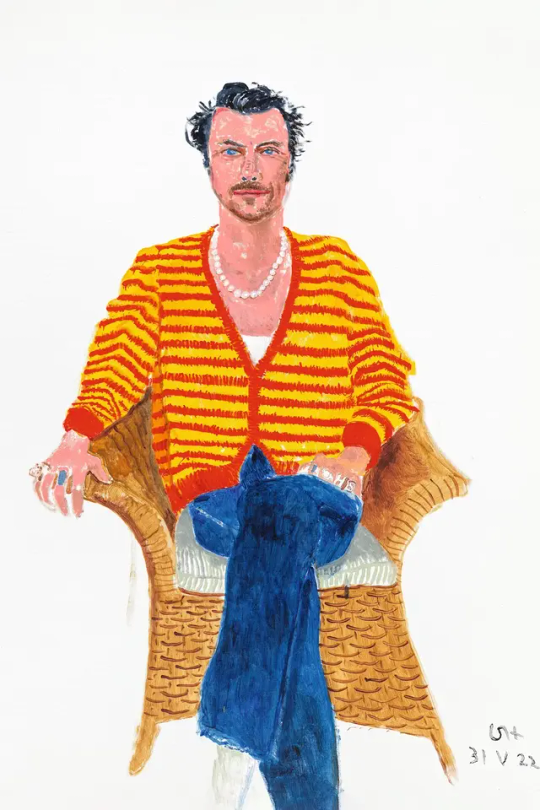
A legendary painter and a pop lodestar? Sparks were inevitable. David Hockney and Harry Styles share a very special sitting with Liam Hess
What’s the secret to a great portrait? At 86 years old, David Hockney has a few ideas. A lifetime of looking has taught him to always start with the face. “I begin with the head first,” he says, matter-of-factly, from his home in France. “From there, I place everything else.”
That was his approach when, late last May, Harry Styles travelled to his light-filled studio in Normandy and stationed himself on a cane chair, ready to become the esteemed artist’s latest subject. Over two days, Hockney worked to capture the exact hues of red and yellow in Styles’s striped cardigan, the indigo of his jeans, the string of pearls at his neck – not to mention the unmistakable tousled fringe of one of the world’s biggest pop stars. For the artist, though, the goal was merely to capture the essence of the person in front of him. “I wasn’t really aware of his celebrity then,” Hockney says, with a shrug. “He was just another person who came to the studio.”
The pair struck up an instant rapport that was likely helped by Styles being a full-on fanboy. For his US Vogue cover shoot in 2020, Styles wore a pair of hand-painted Bode cords that featured a talismanic illustration of Hockney by artist Aayushia Khowala. It’s also hard to imagine the wide-eyed wonder of a flamboyant Brit discovering the sunny thrills and spills of California – a theme, and sound, that has permeated the former One Direction singer’s solo albums – without Hockney as a precedent. “David Hockney has been reinventing the way we look at the world for decades,” says Styles. “It was a complete privilege to be painted by him.”
The unveiling of the portrait kicks off the second iteration of the National Portrait Gallery’s Hockney exhibition Drawing From Life, which first opened in February 2020, only to close weeks later due to the pandemic. With the addition of a new room of pictures charting Hockney’s creative impulses throughout lockdown, the show returns on 2 November – a few months after a refurbishment of the entire museum – with Styles’s portrait as its crown jewel. “The whole world shut down, and the exhibition was still sitting there, in the dark,” recalls Sarah Howgate, the gallery’s senior curator of contemporary collections, who oversaw the exhibition in both phases. “So it’s nice to know it will have another life.”
The Styles painting may bring star wattage, but the unassuming genius of Hockney’s portraiture is still the main exhibition draw. What makes his images tick, you quickly learn, is their honesty: whether in the tension bubbling beneath the surface of his famed double portrait of Ossie Clark and Celia Birtwell, painted between 1970 and ’71, or the seated figures that populated his 2016 Royal Academy of Arts exhibition, which included the likes of his own sister, Margaret, and the late comedian Barry Humphries. Hockney’s eye for the human figure may be playful, often kaleidoscopic, sometimes fantastical – but it’s always, most importantly, frank.
Styles’s portrait will hang alongside those of writer Gregory Evans, Hockney’s printer Maurice Payne, the mayor of his local town Dozulé, his gardener and even his chiropodist, or in Hockney’s words, “the dandy who cuts my toenails” .
One of his more recent subjects was the eminent music producer Clive Davis, who first suggested inviting Styles to swing by. “Clive told me about Harry’s new album, and JP [Hockney’s studio assistant] sent Harry a note and asked him if he’d like to come to my studio and sit for his portrait,” Hockney remembers. “He replied straight away and said, yes, he’d love to.” From there, Hockney’s process of painting Styles was instinctive. “Everybody just came to sit,” he says, breezily, before admitting: “Now I know Harry’s a celebrity, though: I’ve seen all his music videos.”
“He’s not a traditional portrait painter,” says Howgate. Hockney’s interest is not in what people do, but rather in who they are. “He’s not interested in fame. He’s interested in depicting people and their relationships.” It’s why his eye is primarily trained on his inner circle these days – but it also pays testament to his enduring curiosity that he’s still willing to open that up to a newcomer every so often. Styles seems to know how lucky he is, adding, with a tinge of disbelief: “I’m in awe of the man with enough one-liners for a lifetime.” As to what those one-liners might be? Styles and Hockney’s mutual silence on that question suggests that what happens in the studio, stays in the studio.
via vogue.co.uk
133 notes
·
View notes
Text
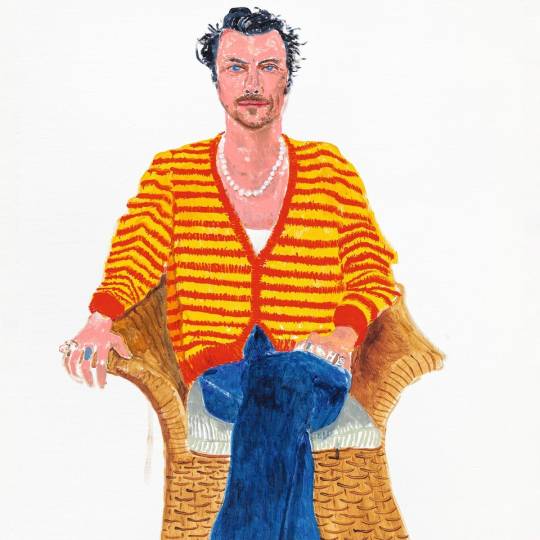
What’s the secret to a great portrait? At 86 years old, David Hockney has a few ideas. A lifetime of looking has taught him to always start with the face. “I begin with the head first,” he says, matter-of-factly, from his home in France. “From there, I place everything else.”
That was his approach when, late last May, Harry Styles travelled to his light-filled studio in Normandy and stationed himself on a cane chair, ready to become the esteemed artist’s latest subject. Over two days, Hockney worked to capture the exact hues of red and yellow in Styles’s striped cardigan, the indigo of his jeans, the string of pearls at his neck – not to mention the unmistakable tousled fringe of one of the world’s biggest pop stars. For the artist, though, the goal was merely to capture the essence of the person in front of him. “I wasn’t really aware of his celebrity then,” Hockney says, with a shrug. “He was just another person who came to the studio.”
The pair struck up an instant rapport that was likely helped by Styles being a full-on fanboy. For his US Vogue cover shoot in 2020, Styles wore a pair of hand-painted Bode cords that featured a talismanic illustration of Hockney by artist Aayushia Khowala. It’s also hard to imagine the wide-eyed wonder of a flamboyant Brit discovering the sunny thrills and spills of California – a theme, and sound, that has permeated the former One Direction singer’s solo albums – without Hockney as a precedent. “David Hockney has been reinventing the way we look at the world for decades,” says Styles. “It was a complete privilege to be painted by him.”
The unveiling of the portrait kicks off the second iteration of the National Portrait Gallery’s Hockney exhibition Drawing From Life, which first opened in February 2020, only to close weeks later due to the pandemic. With the addition of a new room of pictures charting Hockney’s creative impulses throughout lockdown, the show returns on 2 November – a few months after a refurbishment of the entire museum – with Styles’s portrait as its crown jewel. “The whole world shut down, and the exhibition was still sitting there, in the dark,” recalls Sarah Howgate, the gallery’s senior curator of contemporary collections, who oversaw the exhibition in both phases. “So it’s nice to know it will have another life.”
The Styles painting may bring star wattage, but the unassuming genius of Hockney’s portraiture is still the main exhibition draw. What makes his images tick, you quickly learn, is their honesty: whether in the tension bubbling beneath the surface of his famed double portrait of Ossie Clark and Celia Birtwell, painted between 1970 and ’71, or the seated figures that populated his 2016 Royal Academy of Arts exhibition, which included the likes of his own sister, Margaret, and the late comedian Barry Humphries. Hockney’s eye for the human figure may be playful, often kaleidoscopic, sometimes fantastical – but it’s always, most importantly, frank.
Styles’s portrait will hang alongside those of writer Gregory Evans, Hockney’s printer Maurice Payne, the mayor of his local town Dozulé, his gardener and even his chiropodist, or in Hockney’s words, “the dandy who cuts my toenails” .
One of his more recent subjects was the eminent music producer Clive Davis, who first suggested inviting Styles to swing by. “Clive told me about Harry’s new album, and JP [Hockney’s studio assistant] sent Harry a note and asked him if he’d like to come to my studio and sit for his portrait,” Hockney remembers. “He replied straight away and said, yes, he’d love to.” From there, Hockney’s process of painting Styles was instinctive. “Everybody just came to sit,” he says, breezily, before admitting: “Now I know Harry’s a celebrity, though: I’ve seen all his music videos.”
“He’s not a traditional portrait painter,” says Howgate. Hockney’s interest is not in what people do, but rather in who they are. “He’s not interested in fame. He’s interested in depicting people and their relationships.” It’s why his eye is primarily trained on his inner circle these days – but it also pays testament to his enduring curiosity that he’s still willing to open that up to a newcomer every so often. Styles seems to know how lucky he is, adding, with a tinge of disbelief: “I’m in awe of the man with enough one-liners for a lifetime.” As to what those one-liners might be? Styles and Hockney’s mutual silence on that question suggests that what happens in the studio, stays in the studio.
David Hockney: Drawing From Life will be at the National Portrait Gallery from 2 November to 21 January 2024
111 notes
·
View notes
Text
Perro y Arena at Antler Gallery.


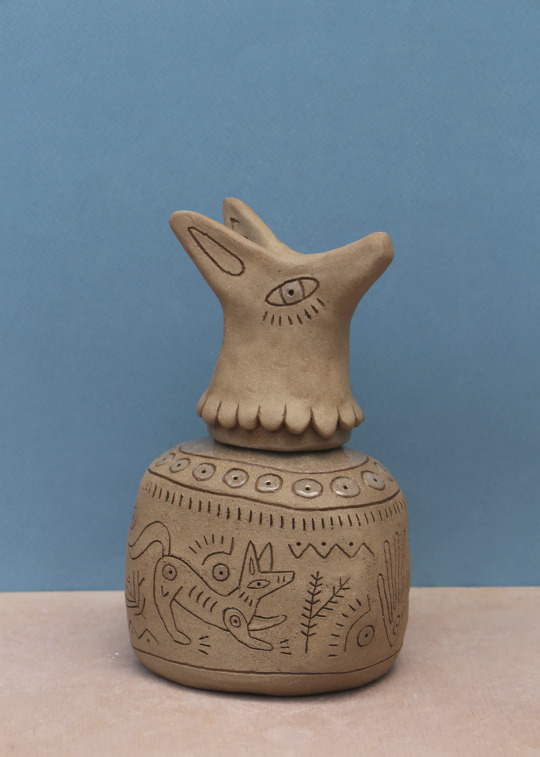




Currently on view with Antler Gallery in Portland, Oregon is artist Perro y Arena's latest amazing sculptures.
Perro y Arena is a creative studio based in Tijuana, Baja California, focused in creating both functional and decorative clay pieces. The project is inspired by the flora and fauna of the Californias and by the Mexican and Greek roots of artist Socrates Medina Ahearn. The textures and tones of the clay resemble the deserts of Baja and the animal figurines connect us to a spiritual and mythological world. One is able to play with coyotes and dance with hares while singing to the moon. Perro y Arena also collaborates with inspiring local creatives that share a similar passion and connection to our natural environment through photography, textiles and fragrances.

THE SUPERSONIC ART SHOP | FOLLOW ON INSTAGRAM
192 notes
·
View notes
Text
Zodiac Signs, Cities & Curious Facts! 🌆
Each city was selected by me from "The Rulership Book" by Rex E. Bills, alongside one fact that matches that particular sign's energy! There are more cities and places that align with the vibration of each sign, but these are the ones I picked for this post. All pictures are from Google Images.
Enjoy this random and (hopefully) fun thread!😁
♈Aries: FLORENCE, Italy
Florence has a unique street festival: The "Calcio Storico" is a traditional street football game played annually there. The game involves four teams representing the four historic quarters of the city, and it's known for its rough and intense style of play!
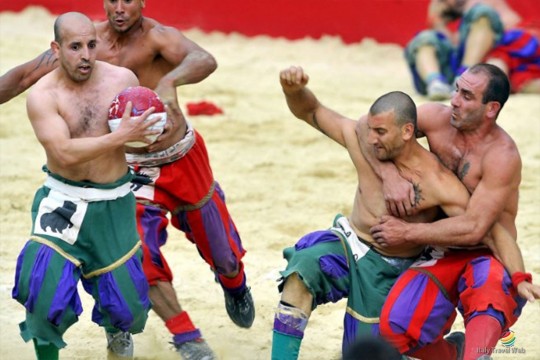
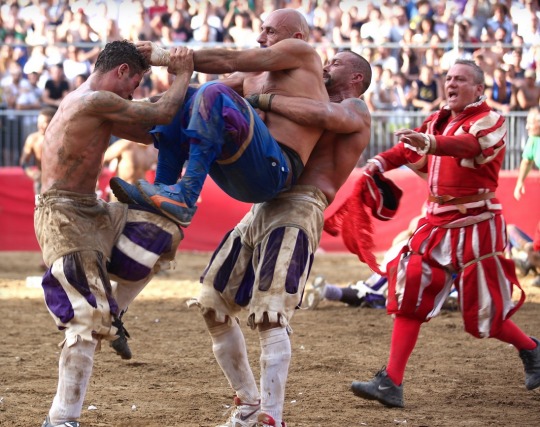
♉Taurus: LEIPZIG, Germany
Leipzig is known as the "City of Music": Leipzig has a rich musical heritage and is considered one of the world's most important cities for classical music. Famous composers such as Johann Sebastian Bach, Richard Wagner, and Felix Mendelssohn Bartholdy have strong connections to Leipzig, and their music is celebrated in the city's numerous concert halls, museums, and festivals.
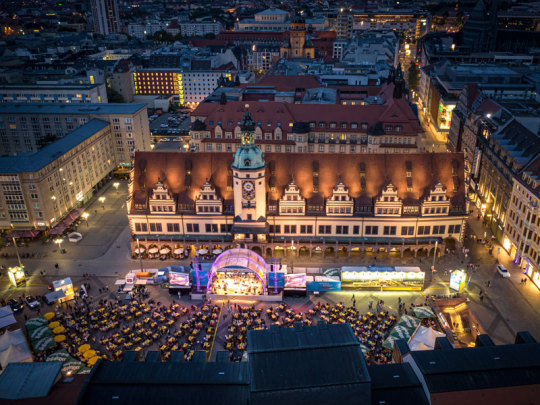
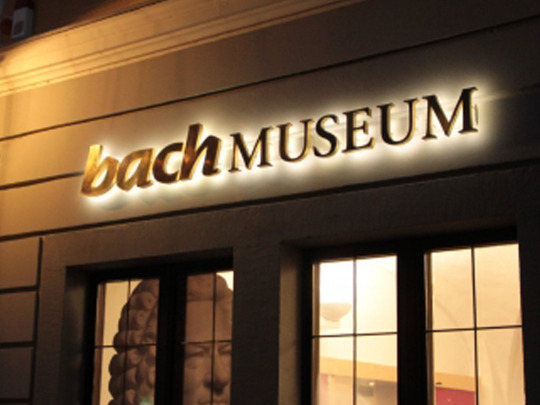
♊Gemini: LONDON, England
London has a "whispering gallery": The Whispering Gallery in St. Paul's Cathedral is a circular gallery that runs around the interior of the dome. Due to its unique acoustics, if you whisper against the wall on one side of the gallery, the sound can be heard on the other side, over 100 feet away.

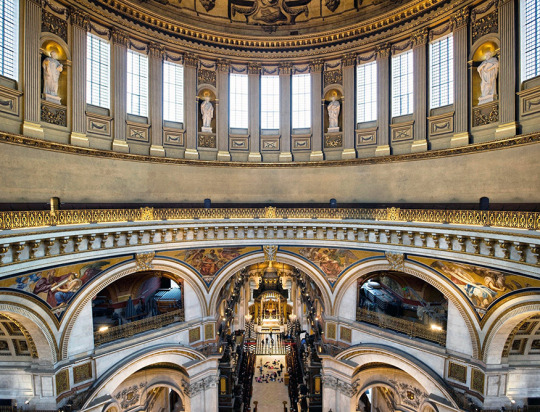
♋Cancer: ISTANBUL, Turkey
Istanbul has a famous street for cats: The "Cat Street" or "Kedi Sokak" in Turkish is a narrow street in the historic district of Sultanahmet that is home to dozens of stray cats. The cats are well-fed and cared for by locals, and the street has become a popular tourist attraction.
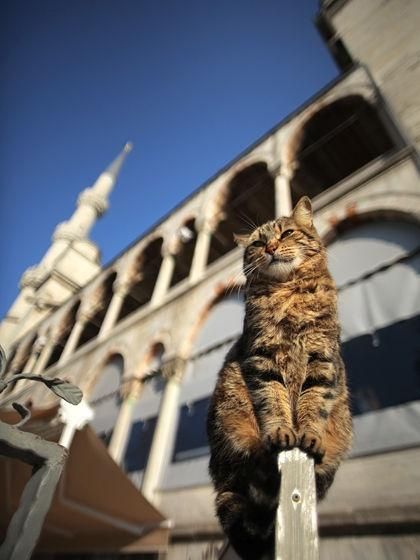

♌Leo: BERLIN, Germany
Berlin is a graffiti artist's paradise: The city has a long history of street art and is home to some of the most famous graffiti murals in the world. The East Side Gallery, a section of the Berlin Wall that has been turned into an open-air gallery, features over 100 paintings by artists from around the world.
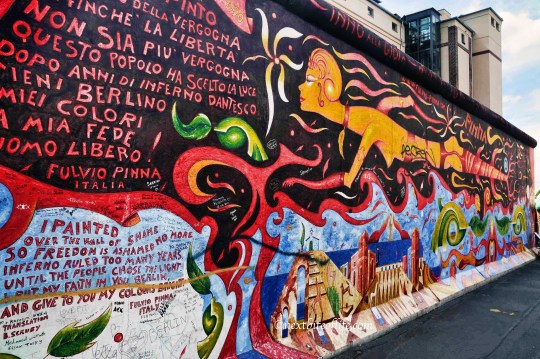
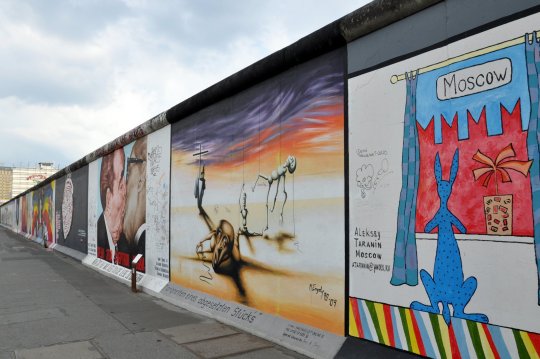
♍Virgo: MOSCOW, Russia
Moscow has a rich literary history: Many famous Russian writers, including Leo Tolstoy, Fyodor Dostoevsky, and Anton Chekhov, lived and worked in Moscow. It also has the largest number of public libraries in the world: "The Russian State Library" , which is the largest library in Europe and the second largest library in the world, after the Library of Congress in the United States.

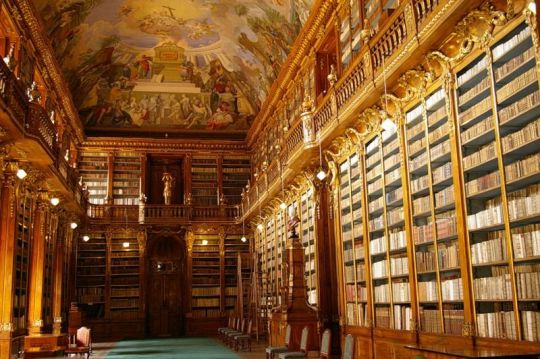
♎Libra: VIENNA, Austria
Vienna has a rich musical history: Vienna has been a center of musical innovation and creativity for centuries and has been home to many famous composers such as Mozart, Beethoven, and Strauss. Today, the city is renowned for its classical music scene and is home to the world-famous Vienna Philharmonic Orchestra.
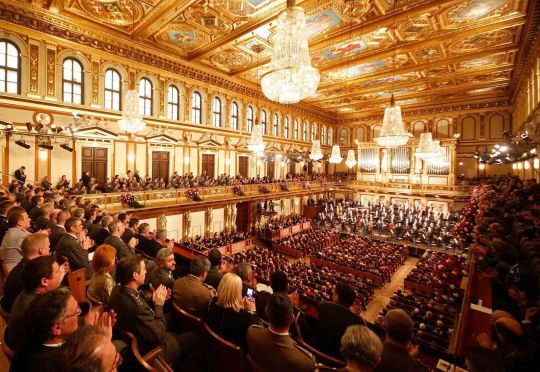

♏Scorpio: TOKYO, Japan
Tokyo has a unique fashion scene: Tokyo's fashion scene is known for its avant-garde and eclectic styles, with Harajuku being the center of youth fashion culture. "Gothic Lolita" is part of Harajuku, and it incorporates darker and more macabre elements into the Lolita fashion aesthetic.

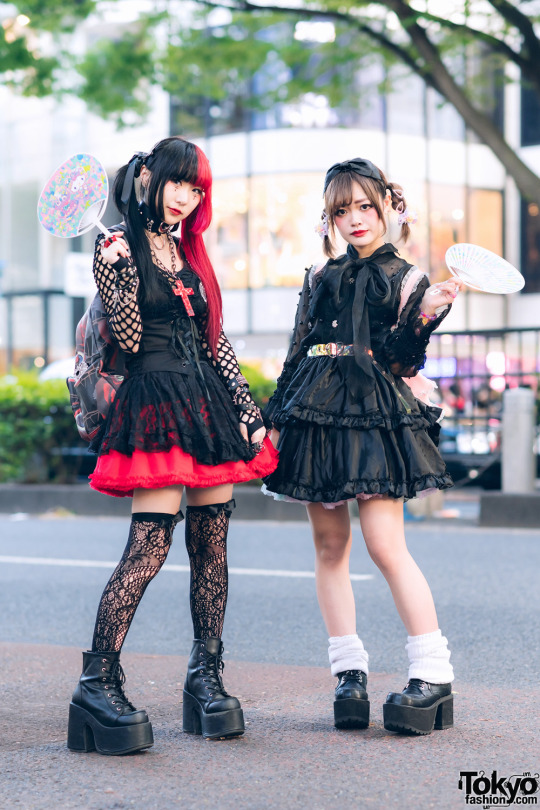
♐Sagittarius: TUSCANY, Italy
Tuscany is home to the oldest university in Europe: The University of Bologna, which is located in Tuscany, is the oldest university in Europe, having been founded in 1088. It is still one of the most prestigious universities in Italy.
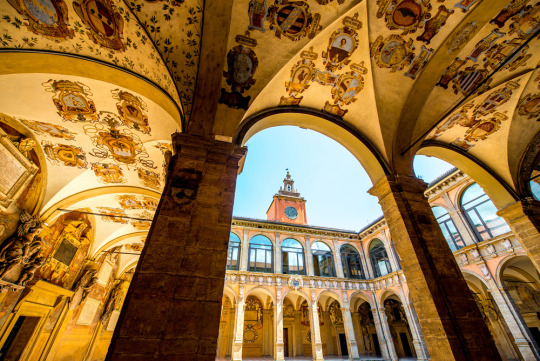
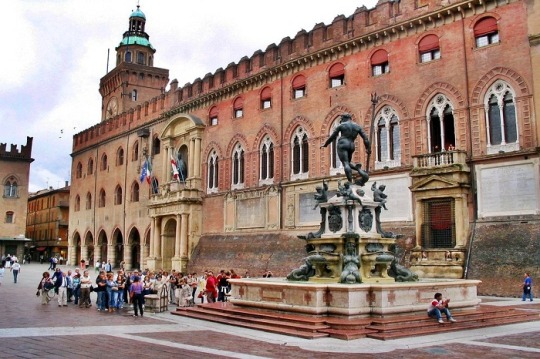
♑Capricorn: BRUSSELS, Belgium
Brussels is home to the "Atomium": The Atomium is a unique architectural structure in Brussels that was built for the 1958 World Exposition. It is designed to represent an iron crystal magnified 165 billion times, and it has become an iconic symbol of the city.
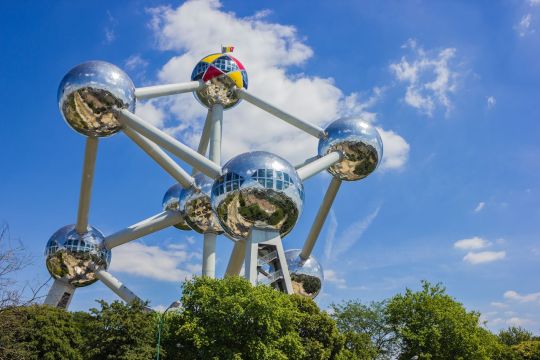

♒Aquarius: LOS ANGELES, California
LA is the birthplace of the Internet: The first successful transmission of a message over the Internet occurred on October 29, 1969, between two computers located at the University of California, Los Angeles (UCLA) and the Stanford Research Institute. This event is considered the birth of the Internet.


♓Pisces: GALICIA, Spain
Galicia is home to an ancient spiritual destination: The Way of St. James, also known as the Camino de Santiago, is a famous pilgrimage route that leads to the cathedral of Santiago de Compostela in Galicia. Every year, thousands of people from all over the world make the 780 km journey on foot, bicycle, or horseback. Many of them walk the route for spiritual reasons, while others enjoy the physical challenge and the opportunity to meet people from all over the world.
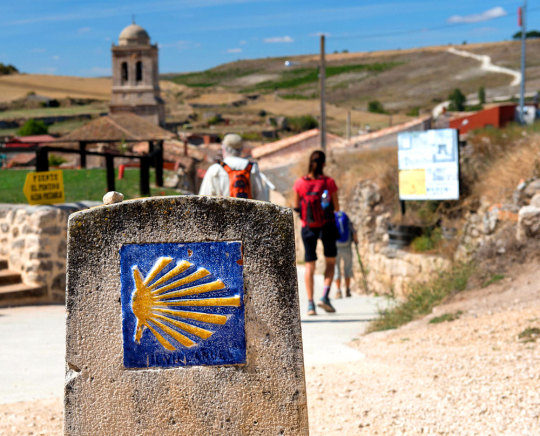

Now, that was a pleasure to put together! How do you feel about the fact/city for your sign? As a Virgo, I'd love to visit the Moscow library, but as a weird/edgy fashion sucker, Tokyo seems like a whole lot of fun! Also, the Aries one made me LOL! Y'all just can't stop fighting, can you? 😂
Which fact/city is your favorite one(s)? Let me know down below! 🖤
- Foxbörn
ᴍᴀꜱᴛᴇʀʟɪꜱᴛ 1
ᴄʜᴀʀᴛ ʀᴇᴀᴅɪɴɢꜱ
ᴡᴀɴᴛ ᴛᴏ ʙᴜʏ ᴍᴇ ᴀ ᴄᴏꜰꜰᴇᴇ?
#astro notes#astrology#astro observations#astrology notes#birth chart#zodiac#astro community#zodiac signs#horoscope#aries#taurus#gemini#cancer#leo#virgo#libra zodiac sign#scorpio#sagittarius#capricorn#aquarius#pisces#travel
134 notes
·
View notes
Photo
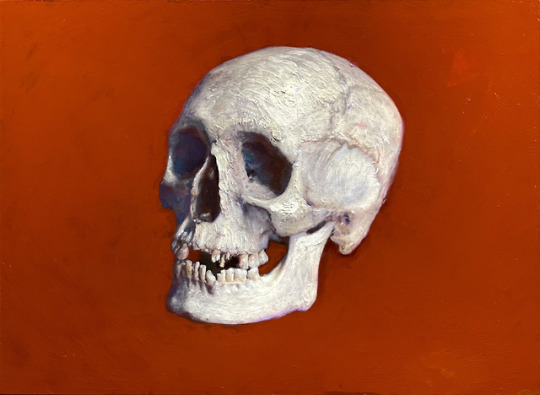
Submitted by Joseph Miller:
Portfolio:
https://www.flickr.com/photos/134913715@N03/sets/72157713915296916/
Joseph A. Miller is an Associate Professor of Art at S.U.N.Y. Buffalo State University, where he has taught drawing and painting since 1997. Miller’s work is in numerous public and private collections, and has been shown internationally in Finland, China, Poland and the Czech Republic, as well as across the United States, from Berkeley, California to Cambridge, Massachusetts. His work is represented by the Art Dialogue Gallery in Buffalo, NY, Meibohm Fine Art in East Arora, NY and the West End Gallery in Corning, NY.
https://artdesign.buffalostate.edu/directory/joseph-miller
I focus primarily on the human figure depicted in environments that create a context for psychologically charged open ended narratives. Many of these narratives explore ideas about power and vulnerability.
Quality of light is a common theme. In particular, the way in which atmospheric light and locale can suggest a sense of mystery and silence. These works are dark, humid and hopefully, at their best, memorable. For me, the most successful are those that evoke the feeling that an event is about to happen or has recently happened.
Images of figures or figures in landscapes, in groups or in isolation, share a common feeling of significance. Wholly absorbed within themselves or the dialogue shared between one another, they wait for the unfolding of their private story.
Beautiful work, thank you or submitting!
126 notes
·
View notes
Text

Gone to rack and ruin?
By Vice Admiral Sir Timothy Laurence | Published 29 July 2020
Country Life Guest Edited by HRH The Princess Royal
What on earth do you do with a ruined, but historically significant country house?
This is a question that plagues the average workaday heritage chairman, causing headaches, insomnia and occasional bouts of teeth-grinding. Here, I will use four examples from the English Heritage portfolio to illustrate the challenges we face. Country Life readers may have their own views about how we should deal with them; if so, I anticipate a flood of letters offering advice. Each site is different and no one solution fits all.

Kirby Hall
Kirby Hall in Northamptonshire was built in the 1570s by Sir Humphrey Stafford and, after his death, by Sir Christopher Hatton, Lord Chancellor. This magnificent house shows all the creative energy and architectural innovation of the first Elizabethan age.
In the 17th century, it hosted five royal visits and boasted one of the finest gardens in England. After four generations of Hattons (all called Christopher in that charming, if rather confusing, English way) it passed to the Winchilsea family, who lived there until the 1770s. Abandoned in the 1830s, it is now roofless, but retains enough of its form for us to imagine how astonishing it would have looked when first built.

John Summerson wrote: ‘The beauty of Kirby’s decline is that it was private and without violence. The house was never burnt, ravaged, used as a quarry or assaulted by mobs.’ English Heritage looks after buildings that suffered exactly those fates, but because Kirby was spared all of them, one can still appreciate there the romance of a lost grandeur.
What should we do with it? The Ministry of Works in the 1960s did its usual thorough, if, by current standards, a little over-zealous, conservation job. Part of the house is still roofed, but leaks are threatening the ceilings underneath. One proposal was to re-roof a further part of the house — the Great Gallery — and use it to display a collection of contemporary furniture, paintings and so on.
That idea has not yet passed the ‘value for money’ test. We are currently working on a modest new exhibition, which will be completed later this year. Major additional work would require a substantial funding package to match.
Sutton Scarsdale Hall

Sutton Scarsdale Hall in Derbyshire is another example of the rise and fall of a noble country house and is one of our greatest conservation challenges.
It was a Baroque masterpiece, built in the 1720s for the 4th Earl of Scarsdale using some of the notable craftsmen of the day. The splendid exterior stonework was carved by Edward Poynton of Nottingham; the Italian master craftsmen Arturi and Vasilli carried out the fine stucco decoration in the principal rooms, remnants of which are still visible.
The cost of the building over-stretched the Scarsdales — an all-too-familiar story, I’m afraid — and the house was sold in the 19th century to a local family, the Arkwrights. In turn, they were forced to sell in 1919 to a company of asset strippers.
Despite the fact that Lord Curzon’s 1913 Ancient Monuments Consolidation and Amendment Act had by then provided the Government with protective powers, many of the hall’s finely decorated rooms were sold off as architectural salvage.
Amazingly, some still survive, but sadly not in Derbyshire: three interiors are displayed at the Museum of Art in Philadelphia and a pine-panelled room is at the Huntington Library in California. The latter was given to the library by a Hollywood film producer, who had used it as a film set for Kitty in 1934. He had bought it from the newspaper magnate and collector, William Randolph Hearst.
More happily, the hall was saved from intended demolition in 1946 by Sir Osbert Sitwell. His descendants handed it to the nation in 1970.
The roofless hall stands proudly on a prominent hill, an important part of the visual landscape of the area and visible from Bolsover Castle across the valley. However, the exposed hilltop location and lack of protection from a roof or glazed windows make the building itself, and especially the exceptionally important plasterwork, acutely vulnerable.
We are currently spending considerable sums patching and making good, but, for a charity such as us, this cannot be a long-term solution. What should we do? One option would be to re-roof the whole hall — at huge expense. Another would be a partial re-roofing to cover the best areas of plasterwork.
A third would be to devise some form of tailor-made protection for the plaster-work in situ, but anything of this nature would have significant aesthetic impact. We have even thought of a private investor taking it over and turning it into a hotel or apartments. All options remain under consideration.
Witley Court
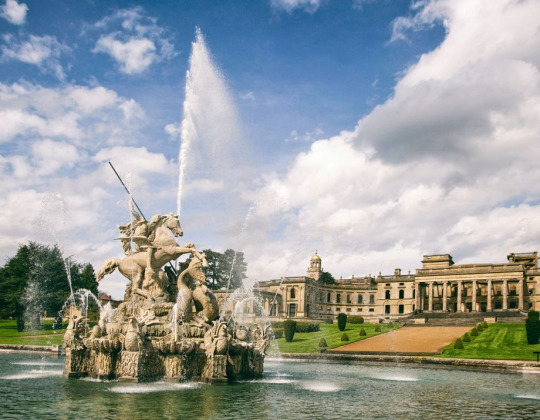
My third example presents a very different set of issues. A new house was built on old foundations at Witley Court in Worcestershire in the early 1500s, but eight generations of the Foley family (all called Thomas — rather proving my earlier point) progressively modernised the Tudor original in Jacobean, then Palladian style, enlarged the park, built a new parish church next door and, in the early 19th century, commissioned John Nash, the leading Regency architect, to remodel the house extensively.
In 1837, ownership passed to Lord Ward, later Earl of Dudley. During the Dudleys’ tenure, the house was transformed into a ‘Victorian palace’ in the Italianate style made fashionable by Prince Albert at Osborne.
The whole house and church were encased in Bath stone; a new wing and a conservatory were added. Among many additions to the gardens was the magnificent Perseus and Andromeda fountain, fed from a new reservoir in the hill behind.
As happened so often elsewhere, the estate began to be broken up after the First World War and, in 1937, a serious fire gutted much of the building. From then until it was taken into public guardianship in 1972, it was stripped of materials and vandalised, but, thereafter, it was stabilised and made accessible. The great fountain continues to operate for an hour each day and looks magnificent after a major restoration in 2004 and further work in 2016, the latter generously funded by Unilever.
Visitors can now enjoy the park and gardens and wander through the house, where the fire has revealed the various stages of its development.
There are no plans to re-roof the main house, but how can we enhance the pleasure of visiting the place and bring more of its history to life? For example, we are considering digitising the many excellent photographs of the interiors taken during its heyday, so that people can call them up on their mobile phones as they walk round.
We would like to refurbish the conservatory as a cafe. This would require expensive works to bring in services, yet those might enable us to produce more events there, following the very successful art exhibition held in 2019 — perhaps that was a harbinger of things to come.
Belsay Hall
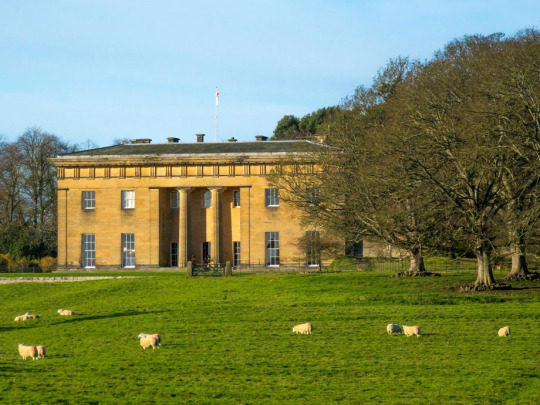
Now, at last, for something with a roof — Belsay Hall in Northumberland. The site comprises three distinct, but related elements: a medieval castle, a 19th-century hall and, linking the two buildings, an outstanding garden. The Middleton family has owned the estate since 1270 and still lives nearby.
The hall’s designer, Sir Charles Monck, drew on the classical ideal he had seen on honeymoon in Greece and transposed the style of a Greek temple into an English villa from 1807 (Fig 6). Its sense of space, balance and rigorous architectural logic were unlike anything seen in Britain. Incidentally, Monck demolished the old village of Belsay on the site and rebuilt it in its current position outside the park — the sort of thing you could do in those days.
He deliberately quarried the stone for the hall in a way that left space for a unique garden, the ravines, pinnacles and sheer rock faces he created inspired by the ancient quarries of Syracuse, Sicily. The gardens still showcase the interplay between natural beauty and the sublime, between wild and tame, from natural woodland through the exotic-ally planted quarry to the more formal terraces and garden rooms near the house.
The family moved from the draughty castle to the new hall on Christmas Day 1817. Sadly, flaws in Monck’s internal guttering system led to wholesale infestation with dry rot. By 1980, when the family handed the buildings and garden into public guardianship, it was unoccupied, unfurnished and stripped of much internal wood and plasterwork. The silver lining of this cloud is that it is now possible better to appreciate features of its design. Standing in the beautiful central atrium,
it does feel more like a temple than a house. The windows are huge, allowing in plenty of natural light, and the acoustics are exceptional, thanks to the empty rooms, vast cellars and a network of flues.
Sound, light and empty space may hold the key to its future use; it is an ideal place for creative programming. We have in the past held innovative fashion and art shows there and have staged acoustic experiences, one with voices broadcast down the chimneys. There will, I am sure, be more of this.
We are in the middle of a major project, part funded by the National Lottery, which includes urgent conservation work, a full restoration of the gardens and a new cafe. The Middleton family and its trustees remain engaged, supportive and, I hope, appreciative of the promise of a new lease of life for Belsay.
These four examples illustrate the enormous technical and financial challenges we face with these and other houses. It’s not unreasonable to ask: why are we doing this? What is the purpose behind a heritage body preserving and/or conserving a building?
Well, we want the places to be informative — to tell us something about the people who built them, about their architectural style, about the people who lived in them or who visited them. It’s all part of explaining the story of England to current and future generations, not only to please or inform expert historians and architects, but to encourage a much wider body of people to see and enjoy our buildings.
From school groups (we host many) to local enthusiasts and anyone who has become fascinated by these places — perhaps after reading about them or seeing a Google arts fly-through online. We hope they will all want to see more, to learn more and enjoy (that word again) the experience.
We have to ask: should we preserve such buildings as they are now, strip them back to their original state when first built or restore them to how they appeared at the height of their glory? With our intact houses — such as Osborne, Apsley or Audley End — the answer is as self-evident as it is with a completely ruined castle or abbey: there really is no option. However, my examples here and others fall between those stools. There are no straightforward answers; we have to look at each on its own merits.
Total returns to past glories are rarely feasible, but allowing further decline is not in our DNA. More commonly, we seek to stabilise each place in a state of ‘sustainable conservation’ — a condition that we can maintain in the long term, avoiding costly repeated repairs. It is an evidence-based way of prioritising work according to historical significance, current condition and a better understanding of the specific causes of deterioration. Once in that state, the typical approach is ‘adaptive re-use’: bringing a building back to life by giving it new uses, which complement, rather than obscure the original.
Above all, these houses must be nurtured and loved so that they can tell their part of the story of England. English Heritage will do what it can, helped by the communities living nearby, many of which provide terrific support — and, perhaps, by the occasional generous benefactor.
77 notes
·
View notes
Text
Still Life 1
I am at a cafe that I first started coming to in the late 90’s. Over half of my life ago. Dana Street Roasting Company in Mountain View, California. It has been decades since I could call myself a regular. I don’t know who anyone here is except for Nick, the owner, and no one here knows who I am - not even Nick, though maybe he once did, a little bit. When I started coming here, when I actually was a regular, the place was called Jumpin Java. Nick still owned it then, the name change came about when he bought a roaster and started selling beans. In the old days, everyone who worked here was a punk who had moved from Austin Texas or somewhere close by, the was a group of five or six of them. The main figure among them was a guy named Aaron who managed the place. He wore tattoos from Wilson’s Illuminatus! Trilogy, constantly played loud industrial music in the cafe, and led the Texas punks. If you were sitting outside and he came out and hung with you for five minutes while taking a smoke break it felt like a great privelege, like being chosen for something. Like most people I knew in Mountain View, he has long since left, first for Arizona, and now I believe he lives in Washington. It was a lively place, for a small boring town like Mountain View, often hard to get a seat unless you knew someone who’s table you could join, and there was a little stage with live jazz and folk bands playing from Thursdays to Sundays, three tables outside for smokers, and also a whole alley where people hung out. There were two other main cafes in Mountain View in those days - Red Rocks and Cuppa Joe’s - which also had decent crowds and live music on the weekends. Also two corporate cafes further up Castro Street, a Starbucks and a Peet’s, but I’m not counting those. Also a branch of a local bagel chain, a fake French bakery, two good pho places, a ramen place, several Indian restaurants with good lunch buffet deals - one of which, Sue’s, also featured a gallery of art by the owner. Also several good dim sum places, a handful of American style Chinese food places, a couple of bars I was too young to have much interest in, a large Chinese grocery store, an excellent taqueria called Los Charros (for the food, but also there was a bartender working there with a famous mustache), a hippy ice cream shop, a small Hong Kong style bakery with great pork rolls, and a number of acupuncture and herbal medecine shops. If you were to sit at a table outside the cafe and look towards Castro street, you’d see an herb shop, an attorney’s office, a small real estate office, and then on the corner there’s Easy Food Company, a Chinese convenience store that sold a wide range of imported goods from snack foods to liqueurs to statues, where I used to buy Parliament Lights for $2.50 a pack.
This town has been through many drastic changes. The above description applies to when I was in my late teens and early twenties. When I came to the downtown area as a young child, it was different, like it came from a different era. Appliance stores that looked like they were from the 50’s, wooden boardwalks on the sidewalks, a weird fake “old west” vibe. But I didn’t spend much time here as a child so I don’t know much more about it beyond that superficial impression.
Now it is over two decades later since the time I describe in the first paragraph. The three tables are still here outside the cafe, and I’m sitting at one of them. But the inside is a jumble of upside down chairs, plastic milk crates, burlap sacks of coffee beans and burlap sacks of burlap sacks. There is nowhere to sit, no music playing, no schedule of upcoming live bands, and nowhere for any bands to play or set up anyway. But the outside part of the cafe is unchanged, and when I look towards Castro street I see the herb shop, the attorney’s office, the real estate place, and Easy Food Company, which still sells a wide range of imported Chinese goods from snack foods to liqueurs to statues and they probably still sell Parliament Lights too, though I’ve long since quit and I doubt they are $2.50 a pack.
Beyond Easy Food, Castro Street itself, is where the most drastic change has occurred. The most obvious change of course is due to the pandemic. Once busy with cars, the street has been blocked off up at California Ave all the way down to the train station, which means about five blocks of it are pedestrian only, and the restaurants and cafes have spilled out into the street. This happened back in 2020, and a number of neighborhing towns did the same. Some of those, like Palo Alto, have reversed course and opened their downtown areas back up to traffic. But in Mountain View this seems to be a more permanent situation, and personally I think it’s a drastic improvement. On evenings and weekends Castro street fills up with families eating at the many restaurants that now have tables in the middle of the street and there are musicians performing on street corners. But if you come here on a weekday morning there are few people around and the lack of cars provides a peaceful atmosphere.
The other massive change is due to the growth of the tech industry, but this is a change that has occurred in waves, again and again, over the course of my life. The phrase “Silicon Valley” is often used in the media and discourse as a shorthand term for the computer/internet/technology business regardless of location, but also Silicon Valley is a physical place, it’s the Santa Clara Valley, and Mountain View is very much in the heart of it. The growth of this industry brings influxes of people - people from all over, but mainly from other parts of the US, from China, and from India and other South Asian countries. My own family came from Massachusetts in the early 80’s. This was of course several decades before Google, Facebook, Twitter, etc. came into being. The main tech companies in those days were Sun, Hewlett-Packard, Apple still a fledgling but very quickly growing. In those days it felt more concentrated down in San Jose, Santa Clara, Sunnyvale, towns where you’d see these huge corporate “office parks”. By the time I left for college there was another “tech boom” with a different suite of companies, this time around the internet. The age of Yahoo, Hotmail, Geocities, the personal web page, the AltaVista search. I wasn’t in the Bay Area at the time, and what I heard was that it changed a lot and then changed back. It was a bubble that burst. But it was to be one of several. There was another, later growth of the industry around a new set of internet companies - the ones we are dealing with now. Google in particular probably had more of an effect on Mountain View than most, when they set up a massive campus here. Now as I write this, any random person I see on the street in this town or a neighboring town has a good chance of either being an employee of one of those massive tech companies, or of being someone who was recently laid off by one of them.
In terms of this town, and my place in it, the change is both bad and good. The inequality gap has grown wider, and personally there is no way I could afford to live here now, unless my fortunes were to drastically change. I only come to this area a few times a year, when visiting my wife’s family, who are the only people I still know in this part of the Bay. All of the wonderful types of food that I describe in the first paragraph are here, and more, if not the exact same places. Los Charros is now called La Espuala, but the menu is the same, even if the guy with the mustache no longer works there. There are many good Indian restaurants, though they no longer offer cheap lunch buffets. Red Rocks, one of the other independent cafes, is also still around and even has an open mic night once a week, and more places to sit than Dana Street - but their coffee just isn’t as good. Some of the places are the same - one of the pho places that I used to go to on lunch breaks when I was a telemarketer is still here, and still looks the same. A lot of the other places are essentially just more expensive or “prestige branded” versions of the places that were here before, and there are a lot more of them, and even if I can’t afford to live here I can at least, sometimes, afford eating here, and in fact after I finish writing here I’m going to go to the Hong Kong bakery to get a pork roll.
During the time while I was writing this, someone came and joined me at the table to do some work on a laptop. After some time they mentioned that they “used to come here a long time ago” and I thought it was so odd that I was writing about the exact same subject, and wondered if this was someone I used to know. But further conversation revealed that by “a long time ago” they meant 2012, while I was thinking of the previous century.
If you’ve read all this, for whatever reason: this isn’t a story or a polemic. There’s no point to it. Just writing for the sake of writing, background without a foreground.
23 notes
·
View notes
Text
Headcanons I have for Sarina Bhonsle.
She was born and raised in Southern California.
Bhonsle is pronounced bons-lee. (One of the DnD guys in "And some Dude Named Jeff" pronounced it bon-sel. But I think he'd only seen the name written and was using spelling pronunciation and not the correct pronunciation.)
In high school, she went through a western movie phase. She still has a small DVD collection of her favorite movies.
She was on her high school's yearbook committee.
She worked as a hostess during high school.
She attended USC Annenberg in Los Angeles. She got a Bachelor's degree in Journalism and minored in Justice, Voice, and Advocacy. She then got her Master's in Specialized Journalism (Arts and Culture)
She wrote for her college newsletter.
During college she worked at a photography store.
After college she continued living in LA.
She was an arts and culture journalist.
She fiddles with her rings when she's nervous
While doing a piece on a local art gallery, she uncovered that it was a front for an art forging and smuggling ring. After which she became an investigative reporter.
She moved to Portland, Oregon to write for The Oregonian.
She enjoys french press coffee.
She collects novelty mugs.
She saw the ley lines (supercharged by Prospero) which started her on the path to investigating magic.
She's a self taught hacker.
She's Indian-American with Pakistani heritage. Most of her family came from the Indian state Maharashtra.
She has a lotus tattoo on her sternum.
She's won five prizes in journalism. Three in arts and culture journalism and two in investigative journalism.
She was once a finalist for a Pulitzer.
Her parents died in a car crash when she was in college.
After getting fired from The Oregonian, Sarina began a blog to write about The Library, D.O.S.A, and her investigations into magic. After meeting Jake she takes down the blog.
She has trouble finding a new job after the team building camp shut down. She eventually gets a job at Portland Monthly Magazine and gets back in to arts and culture journalism.
She's claustrophobic.
She's fluent in French and she spent a semester abroad in Paris.
3 notes
·
View notes
Text

I’m gonna have my first event at the Haze Rio Vista dispensary so feel free to stop by on January 7th
#stoner life#stoner art#artists on tumblr#digital artist#art event#art gallery#digital art#art#california artist#rio vista ca#local black artist#personal tidbits from cannabrer#blender eevee#3d artist drawing#3d artist blender#3d artist#3d artwork#california gallery#gallery event#january 2023#anime digital artist#digitalart#events 2023#weed dispensary#California dispensary#recreational dispensary
2 notes
·
View notes
Text
Weather Forecast for Venice Beach, California: What to Expect
Planning a trip to Venice Beach, California? One of the key factors to consider when preparing for your visit is the weather. In this comprehensive guide, we provide you with all the essential information you need to know about the weather in Venice Beach, California, including average temperatures, seasonal variations, and tips for making the most of your visit regardless of the forecast.
Understanding the Climate Beaches in Venice:
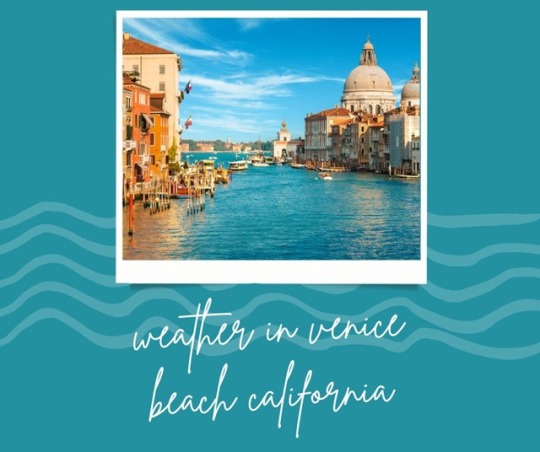
1. Mild Mediterranean Climate:
Venice Beach enjoys a mild Mediterranean climate characterized by warm, dry summers and mild, wet winters. This coastal location benefits from the moderating influence of the Pacific Ocean, resulting in relatively stable temperatures throughout the year.
2. Average Temperatures:
During the summer months, temperatures in Venice Beach typically range from 70°F to 80°F (21°C to 27°C), with occasional heatwaves pushing temperatures higher. In contrast, winter temperatures hover between 55°F to 65°F (13°C to 18°C), with occasional dips into the 40s°F (4°C to 9°C) during colder periods.
3. Seasonal Variations:
While Venice Beach experiences relatively mild weather year-round, there are noticeable seasonal variations in temperature and precipitation. Summer months (June to August) are typically warm and dry, ideal for beach activities and outdoor pursuits. In contrast, winter months (December to February) are cooler and wetter, with occasional rain showers and cooler temperatures.
What to Pack
1. Summer Essentials:
If you're visiting Venice Beach during the summer months, be sure to pack lightweight clothing, sunscreen, sunglasses, and a wide-brimmed hat to protect yourself from the sun's rays. Additionally, don't forget to bring a swimsuit, beach towel, and flip-flops for enjoying the surf and sand.
2. Winter Layers:
For visits during the winter months, layering is key to staying comfortable in fluctuating temperatures. Pack a mix of sweaters, long-sleeved shirts, jeans, and a waterproof jacket or coat to stay warm and dry during cooler weather and occasional rain showers.
3. All-Weather Gear:
Regardless of the season, it's always a good idea to bring along a reusable water bottle, comfortable walking shoes, and a light sweater or jacket for cooler evenings. Don't forget to pack a camera or smartphone to capture memories of your trip to Venice Beach.
Making the Most of Your Visit
1. Beach Activities:
Regardless of the weather, Venice Beach offers a variety of activities for visitors to enjoy. From swimming and sunbathing to beach volleyball and surfing, there's something for everyone to experience along the iconic shoreline.
2. Indoor Attractions:
If the weather isn't cooperating, don't worry—Venice Beach is home to a variety of indoor attractions and activities to explore. Visit the Venice Beach Boardwalk for shopping and dining, explore local art galleries, or take a leisurely stroll through the historic Venice Canals.
3. Stay Informed:
Keep an eye on the weather forecast leading up to your visit and be prepared to adjust your plans accordingly. Check local weather websites or download a weather app to stay informed about any changes in conditions during your stay.
Conclusion
In conclusion, understanding the weather in Venice Beach, California is essential for planning a successful trip to this iconic destination. Whether you're visiting during the sunny summer months or the cooler winter season, knowing what to expect can help you make the most of your visit and enjoy all that Venice Beach has to offer.
2 notes
·
View notes
Text
Road Tripping through California's Coastal Paradise: A Symphony of Beaches, Surf, and Sunsets

California's coastline is a haven for beach lovers, surfers, and nature enthusiasts alike. From the iconic Golden Gate Bridge to the laid-back vibes of Santa Monica, this coastal journey offers endless opportunities for exploration. Cruise along the Pacific Coast Highway, stopping at charming towns, sun-kissed beaches, and world-class surf spots.
Introduction
Welcome to the sun-soaked shores of California, where the Pacific Ocean kisses the coastline in a harmonious dance of waves and where every bend in the road unveils a new chapter of coastal beauty. With a decade of travel experience, I invite you to join me on an unforgettable road trip through California's coastal paradise. From the majestic Golden Gate Bridge to the relaxed ambiance of Santa Monica, this journey is a symphony of beaches, surf, and breathtaking sunsets.
The Pacific Coast Highway: A Ribbon of Scenic Wonders

Setting the Stage: The Golden Gate Bridge
Our coastal adventure begins in San Francisco, home to the iconic Golden Gate Bridge. As the crimson-orange towers rise against the backdrop of the fog-kissed bay, it's a visual overture to the wonders that await on this journey. Take a leisurely stroll along the bridge's pedestrian walkway for panoramic views of the city, Alcatraz Island, and the Pacific Ocean.
Cruising Along Highway 1
Hit the road on the legendary Pacific Coast Highway (Highway 1), a ribbon of asphalt that hugs the rugged coastline. The journey is as much about the drive as it is about the destinations. With the Pacific Ocean to your west and cliffs adorned with wildflowers to your east, the scenery is a constant companion.
Charming Towns and Coastal Retreats
Half Moon Bay: Coastal Tranquility

Our first pitstop is Half Moon Bay, a coastal town known for its laid-back atmosphere and pristine beaches. Explore the historic Main Street, lined with boutique shops and charming cafes. For nature enthusiasts, a visit to the Fitzgerald Marine Reserve unveils tide pools teeming with marine life.
Santa Cruz: Surfing Capital
Continue south to Santa Cruz, the quintessential surf town. Feel the salty breeze as you stroll along the Santa Cruz Wharf or test your skills at the iconic Steamer Lane surf spot. The Santa Cruz Beach Boardwalk adds a nostalgic touch with its vintage rides and seaside attractions.
Carmel-by-the-Sea: Quaint Elegance
As the road winds through cypress-lined cliffs, you'll arrive at Carmel-by-the-Sea. This picturesque town exudes charm with its fairytale cottages, art galleries, and white-sand beaches. Take a scenic walk along 17-Mile Drive for postcard-perfect views of the rugged coastline and the famous Lone Cypress.
Big Sur: Majestic Landscapes
Big Sur, a crown jewel of California's coast, beckons with its dramatic cliffs, redwood forests, and artistic retreats. McWay Falls, a waterfall cascading onto a pristine beach, is a must-see. Breathe in the fresh air as you navigate the winding roads, and be prepared for jaw-dropping vistas at every turn.
Sun-Kissed Beaches and World-Class Surf
Pfeiffer Beach: A Hidden Gem

Tucked away in Big Sur is Pfeiffer Beach, a hidden gem known for its purple-hued sands. Marvel at the unique rock formations, including the famous Keyhole Arch. Sunset is a magical time here, as the fading light paints the rocks and waves in a palette of warm tones.
Malibu: Surfing in Paradise
As you head towards Southern California, Malibu awaits with its glamorous beaches and world-class surf breaks. Zuma Beach is a favorite among surfers and sunbathers alike. Whether you're catching waves or simply soaking up the sun, Malibu embodies the epitome of the California surf culture.
Huntington Beach: Surf City USA
Continue south to Huntington Beach, crowned as Surf City USA. The International Surfing Museum is a tribute to the sport's rich history, while the Huntington Beach Pier provides panoramic views of the coastline. Join locals and visitors alike as they embrace the surfing lifestyle that defines this vibrant beach community.
Nature's Spectacle: Coastal State Parks
Julia Pfeiffer Burns State Park
Return to the coastline, and venture into Julia Pfeiffer Burns State Park, where lush forests meet the sea. The Overlook Trail offers breathtaking views of McWay Falls and the surrounding coastline. It's a sanctuary of tranquility, with the rhythmic sounds of crashing waves and the rustling leaves creating a symphony of nature.
Point Lobos State Natural Reserve
Explore the pristine beauty of Point Lobos State Natural Reserve, often referred to as the "crown jewel" of California's state park system. Hike along coastal trails that lead to hidden coves, and witness seals, sea lions, and a variety of bird species. The reserve is a testament to California's commitment to preserving its natural treasures.
Santa Monica: The Grand Finale
Sunset at the Santa Monica Pier
As our coastal journey reaches its grand finale, Santa Monica welcomes you with open arms. The iconic Santa Monica Pier, with its Ferris wheel and carnival atmosphere, sets the stage for a perfect ending. Join the locals for a sunset stroll along the sandy shores or ride the Ferris wheel for a panoramic view of the coastline bathed in the golden hues of dusk.
Embracing the Laid-Back Vibes
Santa Monica's laid-back vibes make it an ideal spot to unwind after the road trip. Explore the vibrant Third Street Promenade, dotted with shops, restaurants, and street performers. The beachfront bike path invites you to rent a bike and pedal along the ocean, embracing the carefree spirit of Southern California.
Practical Tips for Your Coastal Adventure
Timing Your Trip
The beauty of California's coast is accessible year-round, but certain seasons offer unique experiences. Spring and fall provide pleasant weather and fewer crowds, making it an ideal time for a road trip. Summers can be busy, especially in popular beach towns, while winter brings the possibility of dramatic storm-watching scenes.
Pack Essentials for the Drive
Ensure your road trip is smooth by packing essentials. Sunglasses, sunscreen, and comfortable clothing are a must, as are your camera and binoculars for wildlife watching. Plan your accommodations in advance, especially during peak seasons, to secure the best beachfront stays.
Embrace Spontaneity
While it's essential to plan key stops and accommodations, leave room for spontaneity. Some of the best experiences on this coastal journey may come from impromptu detours to hidden beaches or roadside attractions. Embrace the freedom of the open road.
Conclusion
In conclusion, road tripping through California's coastal paradise is a journey that transcends the ordinary. From the misty cliffs of Big Sur to the sandy shores of Santa Monica, every mile is a brushstroke in a masterpiece of nature. As a seasoned traveler, I can attest that this coastal symphony of beaches, surf, and sunsets is an ode to the soul-stirring beauty of California's coastline. So, buckle up, roll down the windows, and let the salty breeze guide you on an unforgettable road trip along the sunlit shores of the Golden State.
2 notes
·
View notes
Text
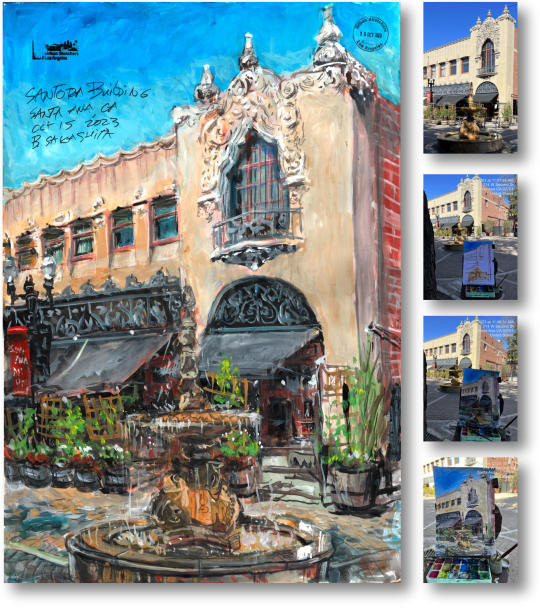
Today's Sketching Event with the Urban Sketcher Los Angeles. What a great selection of location! The site was spectacular! (I added some note about this place at the bottom of the post if anybody wants to know more)
"Santora Building", Santa Ana, California
HIMI gouache on cover stock smooth paper 100 lb 13" x 19" Sketched on location live from 11:07 AM to 12:05 PM, 1 hour
October 15 2023
The Santora Building occupies almost half an acre in the heart of the Santa Ana Arts District at 2nd and Broadway. Locally prominent architect Frank Lansdowne designed the building in 1929 in the Spanish Renaissance Revival style with extensive Churrigueresque ornamentation and ornamental ironwork. Daniger’s Tea Room, famous for its home-cooked meals, delicious tea, cakes and pie that attracted notable Hollywood celebrities, was located in the building in the 1930s and 40s. It also served temporarily as City Hall after the 1933 earthquake damaged the building at 3rd and Main. Today it houses restaurants, galleries, offices and the California Center for Digital Arts. It is a California Historical Landmark and listed on the Santa Ana Register Of Historic Properties and National Register of Historic Places.
#uskla#usklosangeles#油彩画#水彩画#bandedessinée#comic#watercolor#croquis#heritageparkcerritos#citysketch#スケッチ#dessin#manga#urbansketchers#aquarelle#Tebeos#アート#イラスト#グラフィック#デザイン#マンガ#만화#california#santorabuilding#art#urbansketching#watercolorsketch#santaana#watercolorlandscape#watercolorpainting
3 notes
·
View notes
Text
Nexus IV: RAIZ

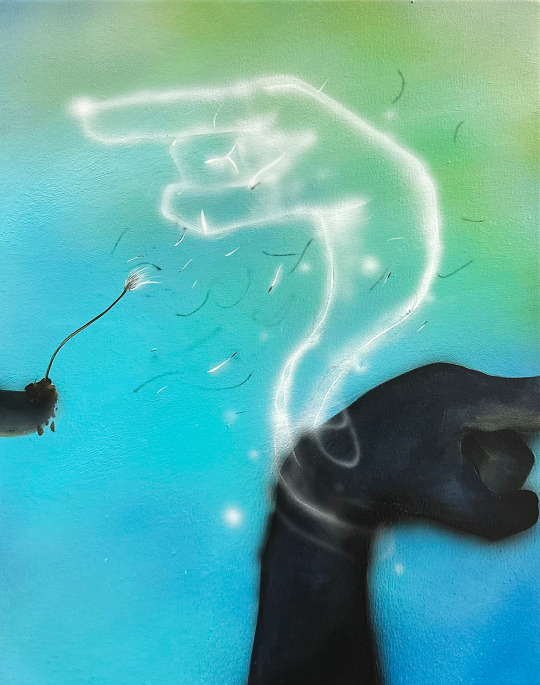
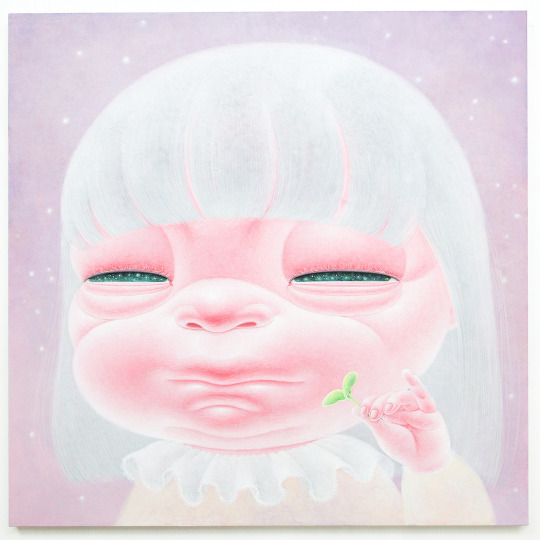
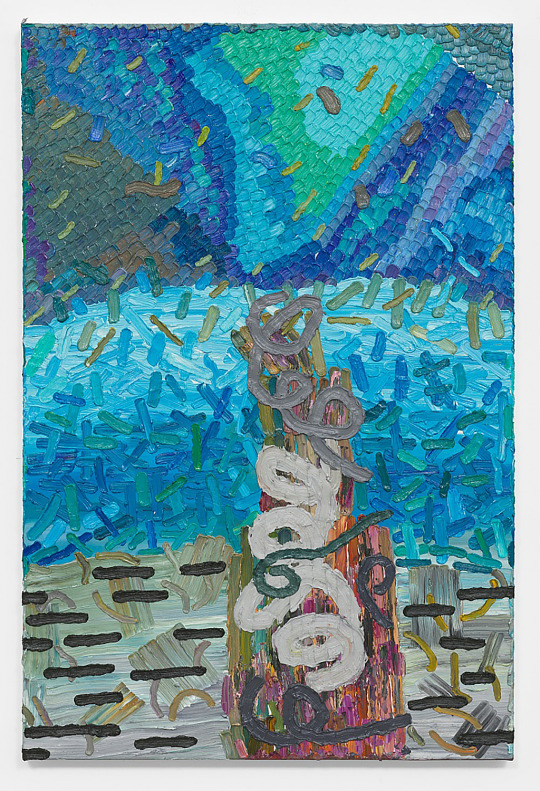
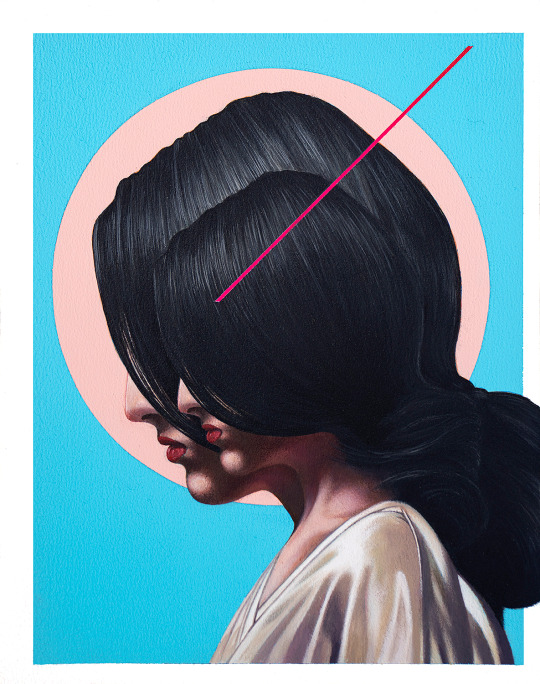

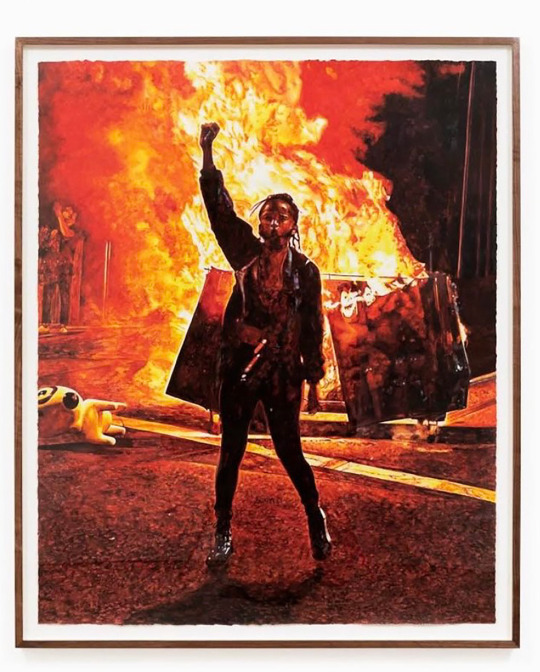
Always in pursuit of uniting and elevating the New Contemporary Art community, Thinkspace Projects has teamed up with Tlaloc Studios and the California Cowboys Collective to present ‘RAIZ', a two month art show currently on view at the Brand Library & Art Center in Glendale, California.
With 60 artists in the group show alone, the extravaganza is sure to be diverse and varied, bringing universal appeal from so many incredible contributors. With a focus on local Los Angeles based artists, the lineup is as impressive as it is varied, including new work from many of the hottest names in the LA scene. Solo shows from Anthony Clarkson, Ken Flewellyn, Matthew Grabelsky, Anthony Hurd, and Cody Jimenez round out the gallery exhibits, filling the walls with innovative and genre-blending pieces across mediums.
It’s not just the walls inside the Art Center, but the walls inside the hallways of the Brand itself as well that are being transformed for this event, with site-specific murals from Brek, LoveYoDreams, and Mr. B Baby adorning the entry hallway area and adjoining courtyard area.

THE SUPERSONIC ART SHOP | FOLLOW ON INSTAGRAM
45 notes
·
View notes
Photo
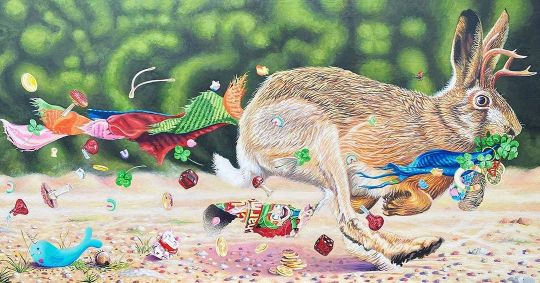
🍀 Lucky Charms 🍀 Having spent his childhood years between California and Guadalajara, Mexico, artist Anthony Solano @brownkid turned to art at a young age, seeing it as both a source of escape and comfort. In high school he was exposed to painting for the first time, sparking what would become his life’s passion. Anthony, a self-taught painter, now resides in Portland, Oregon and credits the local landscape for a major creative shift, from abstract painting to the surreal genre that he currently practices. His work explores today’s environmental conflicts, communicated with vibrant hyper-realistic imagery and thought-provoking storytelling. A sense of optimism and hope within his work allows the viewer to experience a complex, emotional response. (at Modern Eden Gallery) https://www.instagram.com/p/Cp5TednL2ev/?igshid=NGJjMDIxMWI=
3 notes
·
View notes